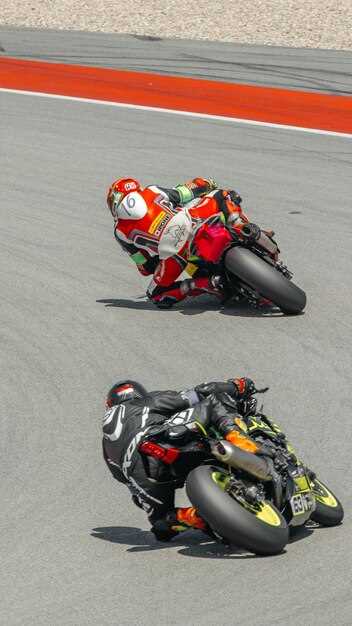
Motorcycle racing is a high-octane sport that captivates millions around the globe, showcasing not only the skill of the riders but also the prowess of the organizations that support them. These organizations play a crucial role in shaping the competitive landscape, driving innovation and ensuring that racing remains a thrilling spectacle for fans and participants alike.
At the forefront of motorcycle racing are various governing bodies and teams that define the rules, organize events, and foster talent. The interplay between these organizations and individual racers is essential for maintaining high standards of safety, performance, and competitiveness. From the technical regulations set forth by organizations such as the Fédération Internationale de Motocyclisme (FIM) to the logistical frameworks of racing series like MotoGP and World Superbike, the foundation for success is meticulously crafted.
Understanding the dynamics of these leading organizations provides valuable insight into the advancements in technology, race strategies, and the growing influence of sponsorships that drive the sport forward. As the racing world continues to evolve, the collaboration between teams, manufacturers, and governing bodies will be pivotal in navigating the challenges and opportunities that lie ahead in the thrilling realm of motorcycle racing.
Analyzing the Structure and Function of Major Racing Leagues

Major motorcycle racing leagues play a crucial role in shaping the competitive landscape of the sport. These leagues are structured to foster talent, ensure safety, and provide a platform for manufacturers and teams to showcase their capabilities. Each league has its unique framework, governing rules, and operational procedures that define how races are conducted and how teams compete.
The primary racing leagues include MotoGP, World Superbike Championship (WSBK), and various national championships. MotoGP, as the pinnacle of motorcycle racing, features a well-defined hierarchy with three classes: MotoGP, Moto2, and Moto3. This structure allows emerging riders to progress through the ranks based on their performance, ensuring a continuous influx of talent into the highest tier.
World Superbike Championship, on the other hand, emphasizes the competitiveness of production-based motorcycles, allowing manufacturers to use their commercial models with limited modifications. This approach attracts a different audience and encourages teams to innovate within the constraints of reality. The championship structure is structured to include both individual rounds and an overall season championship, rewarding consistency and performance throughout the year.
In addition to race formats, leagues often employ a points system to determine standings, which incentivizes teams and riders to strive for podium finishes. The points awarded vary based on finishing positions, ensuring that each race contributes significantly to the overall championship outcome. This competitive nature drives both riders and manufacturers to invest in research and development, ultimately benefitting the sport as a whole.
Furthermore, major racing leagues are supported by extensive sponsorship and marketing strategies, which play a vital role in their financial sustainability. Sponsorship deals not only provide necessary funds for teams but also enhance the visibility and commercial viability of the sport. The interaction between sponsors, teams, and fans creates a dynamic environment that fuels excitement and engagement within racing communities.
Safety is another critical function of major racing leagues. Governing bodies continuously assess and implement rules and technologies aimed at improving rider safety. This includes measures such as advanced telemetry systems, mandatory safety gear, and strict penalties for rule violations. The commitment to rider safety reinforces the leagues’ responsibilities to their participants, ensuring that competitive racing does not compromise well-being.
Finally, the global appeal of motorcycle racing leagues creates a vibrant ecosystem where fans can engage through various platforms, including live events and digital channels. This accessibility helps to grow the sport’s fan base and nurtures local racing communities, while also providing a potential breeding ground for future talent. Overall, the structure and function of major racing leagues are pivotal to the ongoing evolution and promotion of competitive motorcycle racing.
The Role of Sponsorship and Funding in Motorcycle Racing Success

Sponsorship and funding play a crucial role in the success of motorcycle racing teams in various leagues. Financial support allows teams to acquire high-quality materials, state-of-the-art technology, and skilled personnel necessary for competitive performance. Without sufficient backing, teams often struggle to maintain or enhance their competitive edge.
Major sponsors typically invest in teams to enhance their brand visibility. In return, their logos and branding appear prominently on bikes, gear, and team uniforms, providing extensive exposure during racing events. This symbiotic relationship not only aids teams in securing vital resources but also allows sponsors to connect with passionate fans and a broad audience, driving customer engagement and loyalty.
Additionally, funding is essential for research and development. The continuously evolving nature of motorcycle technology demands ongoing investment in innovation and performance enhancements. Teams that can secure substantial funding can better afford testing new designs, optimizing engine performance, and improving aerodynamics, which are all crucial for success on the track.
Furthermore, sponsorship can also facilitate partnerships with manufacturers and other industry players, boosting a team’s credibility and attracting more funding opportunities. This extends beyond financial assets, providing access to extensive networks that can improve a team’s operational strategy and market reach.
In conclusion, sponsorship and funding not only bolster the financial stability of motorcycle racing teams but are also pivotal to achieving competitive success in the leagues. The intricate balance of resources and marketing strategies enabled by sponsorships fosters an environment where teams can thrive and consistently outperform their rivals.
Impact of Technological Innovations on Racing Performance and Safety
In modern competitive motorcycle racing leagues, the integration of technological innovations significantly impacts both performance and safety. Breakthroughs in engineering and materials science have led to the development of lightweight, high-strength components that enhance speed and maneuverability. Advanced aerodynamics play a crucial role in reducing drag, allowing motorcycles to achieve higher velocities on the track.
Additionally, data analytics and telemetry systems have transformed the way teams approach racing strategies. Real-time data collection allows engineers to monitor engine performance, tire conditions, and rider behavior, enabling informed decisions that optimize racing performance. This data-driven approach helps teams to adapt their strategies dynamically during races, leading to better outcomes.
On the safety front, innovations such as improved helmet designs and protective gear have drastically reduced the risk of injury. Technologies like airbag jackets provide an extra layer of protection during crashes, mitigating the impact on riders. Furthermore, electronic stability control and anti-lock braking systems are increasingly integrated into racing motorcycles, helping riders maintain control in challenging conditions.
Moreover, advancements in medical technology have revolutionized the response to injuries. Trackside medical teams are equipped with state-of-the-art diagnostic tools and immediate treatment capabilities, ensuring that riders receive prompt and effective care. These innovations minimize recovery times and improve overall safety in the sport.
In conclusion, the continuous evolution of technology in motorcycle racing leagues not only enhances racing performance but also prioritizes rider safety. As the industry advances, both competitive edges and protective measures will keep evolving, shaping the future of motorcycle racing.
